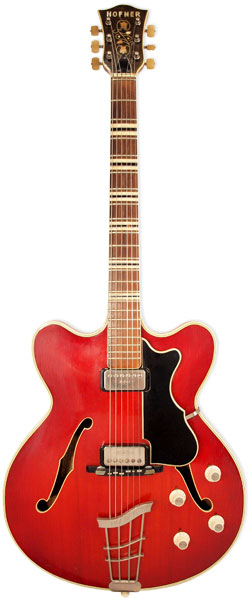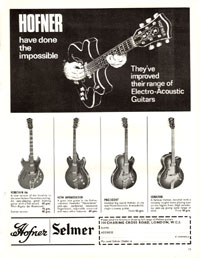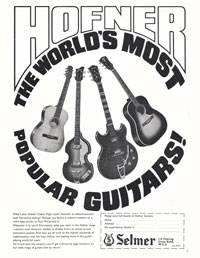

The Verithin, like so many other Hofner models was clearly inspired by the guitars of American manufacturer Gibson, who's 'thinline' range, launched in 1958, had been a massive success. Guitars like the ES-330TD and ES-335TD (generally known as the 330 and 335) were very expensive in Europe, typically out of reach of the majority of musicians, and no British manufacturer was capable of making anything even vaguely similar. So it is no surprise that the Hofner Verithin, debuting in 1960 was an instant success. It was built in Germany, but distributed by Selmer in the UK and Commonwealth, and was first included in Selmer's 1960 catalogue with a price tag of 52 gns. - as the UK equivalent to European model 4574. Like all Hofners of the sixties it underwent subtle changes throughout the period of production, ultimately being retired with the drop in popularity of thinlines in the very early 1970s.
As vintage Hofner guitars go, the Verithin is one of the better known; it was good looking, lightweight, and a more than effective instrument: it had an adjustable truss rod and reasonable pickups. They are still highly desirable to collectors (and to some extent players), and good condition examples change hands for not insignificant sums of money.
As well as having a Gibson-esque thin double Venetian-style cutaway body, with set neck, it was also produced in similar colours to the Gibson models; that is, with a Russet mahogany (sunburst) or Cherry finish. There were some significant differences from the Gibson models though. Although the body style was similar it could hardly be called the same. Whats more, the Verithin was actually very very thin, having a body depth of just 1 1/2" compared to 1 3/4" of the ES-330/335. Both marques used a largely maple body, and rosewood fingerboard, but the Hofner actually had a laminated spruce rather than laminated maple top. The neck material was another significant difference, one-piece mahogany for the Gibson vs laminate maple/beech/maple with volute for the Hofner; they simply do not suffer from the same propensity for neck breaks. The use of single coil pickups and a fully hollow body put this guitar squarely in the ES-330 camp; the 335, of course had a feedback-reducing solid centre block running the length of the body and Gibson's famous humbucking pickups. In 1965 the Hofner Verithin was priced at just £68.5.0d compared to £162.15.0d for the ES-330TD (UK prices); a significant difference.

The Verithin was described in the 1960 Selmer catalogue as follows:
Run your fingers over the frets and you’ll feel the superb proportions of the wonderful "Slendanek" on this elegant instrument. Only craftsmen like Hofner - steeped in years of traditional skill - could combine this with the modern functional lines of this magnificent instrument. Its fine acoustic tone is transmitted through two Hofner Super Response pick-ups to give unequalled treble performance. Acoustic tone is the greatest possible, compatible with the slender design. Beautifully styled for the Professional Player, russet mahogany finish with cambered rosewood fingerboard, and nickel-silver frets. Individual machine heads, inlaid with mother of pearl marquetry. Body Dimensions: 20 1/4" x 16 1/4" x 1 1/4"
The earliest examples were fitted with the Hofner Toaster pickups with, but from then on adhered to the typical Hofner pickup evolution of all models: model 510 "diamond" single coils from late 1961, then model 511 "staple" humbuckers in mid/late 1963. A variation, the Verithin Stereo was first available from 1963, but other than it's stereo wiring was identical.
Other variants included the three-pickup Verithin, and those fitted with a Bigsby tremolo, and of course the Verithin bass. But the biggest change came in late 1965/early 1966, when the model's body was redesigned, losing it's rounded Venetian cutaways in favour of the sharper Florentine body style - reminiscent of the Gibson Barney Kessel - and the guitar was renamed the Verithin 66.
But as the decade came to an end, hollow body guitars in general were losing ground to solid bodies; the Verithin did continue to ship, but in far smaller numbers than in the early sixties. It was still being produced in small numbers into the early 1970s, and was finally included in the 1971 Selmer Guitars & Accessories catalogue.
Hofner have reintroduced several variations of the Verithin as part of it's Contemporary Series, with some changes and upgrades on the vintage originals; for one, they now feature the feedback-reducing center block of the Gibson 335!
Electric guitar advertisements originally published from 1966 onwards. Click on the images for larger copies. Check out other vintage Hofner advertisements

Hofner Verithin - Hofner Have Done The Impossible (1966)
They've improved their range of electro-acoustic guitars
Mid sixties ad for four Hofner electro-acoustic guitars: the Verithin 66, new Ambassador, President and Senator
[more]

Hofner Verithin - Hofner The World's Most Popular Guitars! (1967)
Advertisement for the range of Hofner guitars available in 1967 - showing an example of a Spanish-style acoustic (Hofner Vienna), a bass (500/1 violin 'Beatle' bass), a thinline electric acoustic (...
[more]
€1890
£568
£219